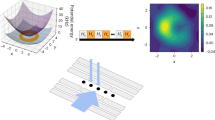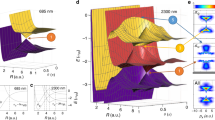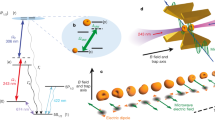Abstract
Conical intersections are ubiquitous in chemistry and physics, often governing processes such as light harvesting, vision, photocatalysis and chemical reactivity. They act as funnels between electronic states of molecules, allowing rapid and efficient relaxation during chemical dynamics. In addition, when a reaction path encircles a conical intersection, the molecular wavefunction experiences a geometric phase, which can affect the outcome of the reaction through quantum-mechanical interference. Past experiments have measured indirect signatures of geometric phases in scattering patterns and spectroscopic observables, but there has been no direct observation of the underlying wavepacket interference. Here we experimentally observe geometric-phase interference in the dynamics of a wavepacket travelling around an engineered conical intersection in a programmable trapped-ion quantum simulator. To achieve this, we develop a technique to reconstruct the two-dimensional wavepacket densities of a trapped ion. Experiments agree with the theoretical model, demonstrating the ability of analogue quantum simulators—such as those realized using trapped ions—to accurately describe nuclear quantum effects.

This is a preview of subscription content, access via your institution
Access options
Access Nature and 54 other Nature Portfolio journals
Get Nature+, our best-value online-access subscription
$29.99 / 30 days
cancel any time
Subscribe to this journal
Receive 12 print issues and online access
$259.00 per year
only $21.58 per issue
Buy this article
- Purchase on Springer Link
- Instant access to full article PDF
Prices may be subject to local taxes which are calculated during checkout



Similar content being viewed by others
Data availability
A repository containing data plotted in Fig. 3 and in Extended Data Fig. 1 is available at https://doi.org/10.5281/zenodo.7955887 (ref. 55).
References
Yarkony, D. R. Diabolical conical intersections. Rev. Mod. Phys. 68, 985 (1996).
Domcke, W., Yarkony, D. R. & Köppel, H. Conical Intersections: Electronic Structure, Dynamics and Spectroscopy (World Scientific, 2004).
Larson, J., Sjöqvist, E. & Öhberg, P. Conical Intersections in Physics (Springer, 2020).
Domcke, W. & Yarkony, D. R. Role of conical intersections in molecular spectroscopy and photoinduced chemical dynamics. Annu. Rev. Phys. Chem. 63, 325–352 (2012).
Berry, M. V. Quantal phase factors accompanying adiabatic changes. Proc. R. Soc. Lond. A 392, 45–57 (1984).
Longuet-Higgins, H. C., Öpik, U., Pryce, M. H. L. & Sack, R. A. Studies of the Jahn–Teller effect II. The dynamical problem. Proc. R. Soc. Lond. A 244, 1–16 (1958).
Mead, C. A. & Truhlar, D. G. On the determination of Born–Oppenheimer nuclear motion wave functions including complications due to conical intersections and identical nuclei. J. Chem. Phys. 70, 2284–2296 (1979).
Schön, J. & Köppel, H. Geometric phase effects and wave packet dynamics on intersecting potential energy surfaces. J. Chem. Phys. 103, 9292–9303 (1995).
Ryabinkin, I. G., Joubert-Doriol, L. & Izmaylov, A. F. Geometric phase effects in nonadiabatic dynamics near conical intersections. Acc. Chem. Res. 50, 1785–1793 (2017).
Mead, C. A. Superposition of reactive and nonreactive scattering amplitudes in the presence of a conical intersection. J. Chem. Phys. 72, 3839–3840 (1980).
Lepetit, B. & Kuppermann, A. Numerical study of the geometric phase in the H + H2 reaction. Chem. Phys. Lett. 166, 581–588 (1990).
Althorpe, S. C. General explanation of geometric phase effects in reactive systems: unwinding the nuclear wave function using simple topology. J. Chem. Phys. 124, 084105 (2006).
Althorpe, S. C., Stecher, T. & Bouakline, F. Effect of the geometric phase on nuclear dynamics at a conical intersection: extension of a recent topological approach from one to two coupled surfaces. J. Chem. Phys. 129, 214117 (2008).
Kendrick, B. Geometric phase effects in the vibrational spectrum of Na3(X). Phys. Rev. Lett. 79, 2431–2434 (1997).
Applegate, B. E., Barckholtz, T. A. & Miller, T. A. Explorations of conical intersections and their ramifications for chemistry through the Jahn–Teller effect. Chem. Soc. Rev. 32, 38–49 (2003).
Englman, R. Spectroscopic detectability of the molecular Aharonov–Bohm effect. J. Chem. Phys. 144, 024103 (2016).
Yuan, D. et al. Observation of the geometric phase effect in the H + HD → H2 + D reaction. Science 362, 1289–1293 (2018).
Yuan, D. et al. Observation of the geometric phase effect in the H + HD → H2 + D reaction below the conical intersection. Nat. Commun. 11, 3640 (2020).
Cina, J. A. & Romero Rochin, V. Optical impulsive excitation of molecular pseudorotation in Jahn–Teller systems. J. Chem. Phys. 93, 3844–3849 (1990).
Cina, J. A. Phase-controlled optical pulses and the adiabatic electronic sign change. Phys. Rev. Lett. 66, 1146–1149 (1991).
Cina, J. A., Smith, T. J. Jr & Romero-Rochin, V. Advances in Chemical Physics (John Wiley & Sons, 1993).
Castro Neto, A. H., Guinea, F., Peres, N. M. R., Novoselov, K. S. & Geim, A. K. The electronic properties of graphene. Rev. Mod. Phys. 81, 109 (2009).
Ran, Y., Wang, F., Zhai, H., Vishwanath, A. & Lee, D.-H. Nodal spin density wave and band topology of the FeAs-based materials. Phys. Rev. B 79, 014505 (2009).
Rashba, E. I. Symmetry of energy bands in wurtzite-type crystals. I. Symmetry of bands neglecting the spin–orbit interaction. Sov. Phys.-Solid State 1, 368 (1959).
Dresselhaus, G. Spin–orbit coupling effects in zinc blende structures. Phys. Rev. 100, 580 (1955).
Cina, J. A. Wave-packet interferometry and molecular state reconstruction: spectroscopic adventures on the left-hand side of the Schrödinger equation. Annu. Rev. Phys. Chem. 59, 319–342 (2008).
Buluta, I. & Nori, F. Quantum simulators. Science 326, 108–111 (2009).
Blatt, R. & Roos, C. F. Quantum simulations with trapped ions. Nat. Phys. 8, 277–284 (2012).
Aspuru-Guzik, A. & Walther, P. Photonic quantum simulators. Nat. Phys. 8, 285–291 (2012).
McArdle, S., Endo, S., Aspuru-Guzik, A., Benjamin, S. C. & Yuan, X. Quantum computational chemistry. Rev. Mod. Phys. 92, 015003 (2020).
Gorman, J. D. et al. Engineering vibrationally assisted energy transfer in a trapped-ion quantum simulator. Phys. Rev. X 8, 011038 (2018).
Duca, L. et al. An Aharonov–Bohm interferometer for determining Bloch band topology. Science 347, 288–292 (2015).
Brown, C. D. et al. Direct geometric probe of singularities in band structure. Science 377, 1319–1322 (2022).
Gambetta, F. M., Zhang, C., Hennrich, M., Lesanovsky, I. & Li, W. Exploring the many-body dynamics near a conical intersection with trapped Rydberg ions. Phys. Rev. Lett. 126, 233404 (2021).
Dereli, T., Gül, Y., Forn-Díaz, P. & Müstecaplğlu, O. E. Two-frequency Jahn–Teller systems in circuit QED. Phys. Rev. A 85, 053841 (2012).
Larson, J. Jahn–Teller systems from a cavity QED perspective. Phys. Rev. A 78, 033833 (2008).
Wang, C. S. et al. Observation of wave-packet branching through an engineered conical intersection. Phys. Rev. X 13, 011008 (2023).
MacDonell, R. J. et al. Analog quantum simulation of chemical dynamics. Chem. Sci. 12, 9794–9805 (2021).
MacDonell, R. J. et al. Predicting molecular vibronic spectra using time-domain analog quantum simulation. Preprint at arXiv https://doi.org/10.48550/arXiv.2209.06558 (2022).
Bersuker, I. B. Modern aspects of the Jahn–Teller effect: theory and applications to molecular problems. Chem. Rev. 101, 1067–1114 (2001).
Monroe, C., Meekhof, D. M., King, B. E. & Wineland, D. J. A ‘Schrödinger cat’ superposition state of an atom. Science 272, 1131–1136 (1996).
Mizrahi, J. et al. Quantum control of qubits and atomic motion using ultrafast laser pulses. Appl. Phys. B 114, 45–61 (2014).
Leibfried, D. et al. Experimental determination of the motional quantum state of a trapped atom. Phys. Rev. Lett. 77, 4281–4285 (1996).
Gerritsma, R. et al. Quantum simulation of the Dirac equation. Nature 463, 68–71 (2010).
Johnson, K. G., Neyenhuis, B., Mizrahi, J., Wong-Campos, J. D. & Monroe, C. Sensing atomic motion from the zero point to room temperature with ultrafast atom interferometry. Phys. Rev. Lett. 115, 213001 (2015).
Flühmann, C. & Home, J. P. Direct characteristic-function tomography of quantum states of the trapped-ion motional oscillator. Phys. Rev. Lett. 125, 043602 (2020).
Jia, Z. et al. Determination of multimode motional quantum states in a trapped ion system. Phys. Rev. Lett. 129, 103602 (2022).
Hayes, D., Flammia, S. T. & Biercuk, M. J. Programmable quantum simulation by dynamic Hamiltonian engineering. New J. Phys. 16, 083027 (2014).
Brownnutt, M., Kumph, M., Rabl, P. & Blatt, R. Ion-trap measurements of electric-field noise near surfaces. Rev. Mod. Phys. 87, 1419 (2015).
Kienzler, D. et al. Observation of quantum interference between separated mechanical oscillator wave packets. Phys. Rev. Lett. 116, 140402 (2016).
Whitlow, J. et al. Simulating conical intersections with trapped ions. Preprint at arXiv https://doi.org/10.48550/arXiv.2211.07319 (2022).
Monroe, C. et al. Resolved-sideband Raman cooling of a bound atom to the 3D zero-point energy. Phys. Rev. Lett. 75, 4011 (1995).
Wineland, D. J. et al. Experimental issues in coherent quantum-state manipulation of trapped atomic ions. J. Res. Natl Inst. Stand. Technol. 103, 259–328 (1998).
Riesebos, L., Bondurant, B. & Brown, K. R. Universal graph-based scheduling for quantum systems. IEEE Micro 41, 57–65 (2021).
Valahu, C. H. et al. Direct observation of geometric phase in dynamics around a conical intersection. Zenodo https://doi.org/10.5281/zenodo.7955887 (2023).
Acknowledgements
We thank J. Whitlow and K. Brown for valuable discussions. We were supported by the US Office of Naval Research Global (N62909-20-1-2047), by the US Army Research Office Laboratory for Physical Sciences (W911NF-21-1-0003), by the US Intelligence Advanced Research Projects Activity (W911NF-16-1-0070), by Lockheed Martin, by the Australian Government’s Defence Science and Technology Group, by the Sydney Quantum Academy (V.C.O.-A., A.D.R., M.J.M. and T.R.T.), by a USyd–UCSD Partnership Collaboration Award (J.B.P.-S., J.Y.-Z. and I.K.), by H. and A. Harley, and by computational resources from the Australian Government’s National Computational Infrastructure (Gadi) through the National Computational Merit Allocation Scheme.
Author information
Authors and Affiliations
Contributions
R.J.M., I.K., C.H. and T.R.T. conceived the original idea. V.C.O.-A., R.J.M., J.B.P.-S., J.Y.-Z. and I.K. developed the theoretical methods. C.H.V., T.N., A.D.R., M.J.M. and T.R.T. carried out the experiments. C.H.V., V.C.O.-A., T.R.T. and I.K. wrote the manuscript with feedback from all authors. All authors discussed the results and interpreted the data.
Corresponding authors
Ethics declarations
Competing interests
The authors declare no competing interests.
Peer review
Peer review information
Nature Chemistry thanks Jeffrey Cina and the other, anonymous, reviewer(s) for their contribution to the peer review of this work.
Additional information
Publisher’s note Springer Nature remains neutral with regard to jurisdictional claims in published maps and institutional affiliations.
Extended data
Extended Data Fig. 1 Characteristic functions of the wavepacket measured for various evolution times.
a-d Joint two-dimensional characteristic function χ(iβ1, iβ2) = p↓χ↓(iβ1, iβ2) + p↑χ↑(iβ1, iβ2) measured at times t = {0, 0.9T, T, 2T} using the full pulse sequence of Fig. 2. The real (left) and imaginary (right) parts are measured with and without an Rx(π/2) pulse in the reconstruction. The top row shows theoretical predictions and the bottom experimental results. χ(iβ1, iβ2) were measured in the range β1, β2 ∈ [0, 4] with 11 × 11 equidistant samples (dashed quadrant). Values in the remaining three quadrants are obtained from the symmetry of χ(iβ1, iβ2). e One-dimensional characteristic functions χ↓(iβ2) and χ↑(iβ2) obtained by omitting displacements on B1 in the reconstruction. β2 was uniformly sampled in the range [0, 5] with 26 points. Each two- and one-dimensional characteristic function was averaged over 1000 and 2000 measurements, respectively. Error bars in e represent one standard deviation based on quantum projection noise.
Extended Data Fig. 2 Frequency drifts of radial motional modes.
a Time series of motional frequencies ω1,2 corresponding to B1,2, measured using the calibration routine detailed in the text and plotted as the frequency offset from ω1 measured at t = 0. b Allan deviation of ω1, and of the difference between the two frequencies (ω1 − ω2).
Rights and permissions
Springer Nature or its licensor (e.g. a society or other partner) holds exclusive rights to this article under a publishing agreement with the author(s) or other rightsholder(s); author self-archiving of the accepted manuscript version of this article is solely governed by the terms of such publishing agreement and applicable law.
About this article
Cite this article
Valahu, C.H., Olaya-Agudelo, V.C., MacDonell, R.J. et al. Direct observation of geometric-phase interference in dynamics around a conical intersection. Nat. Chem. 15, 1503–1508 (2023). https://doi.org/10.1038/s41557-023-01300-3
Received:
Accepted:
Published:
Issue Date:
DOI: https://doi.org/10.1038/s41557-023-01300-3
This article is cited by
-
Seeking a quantum advantage with trapped-ion quantum simulations of condensed-phase chemical dynamics
Nature Reviews Chemistry (2024)



